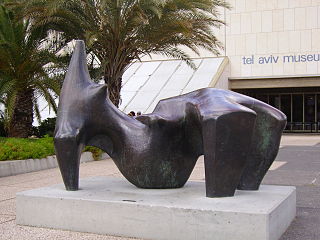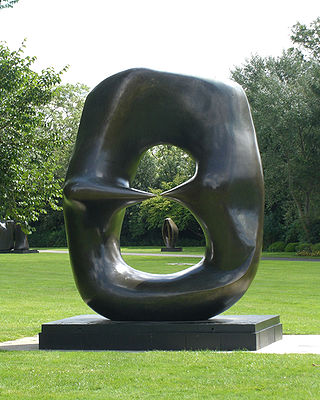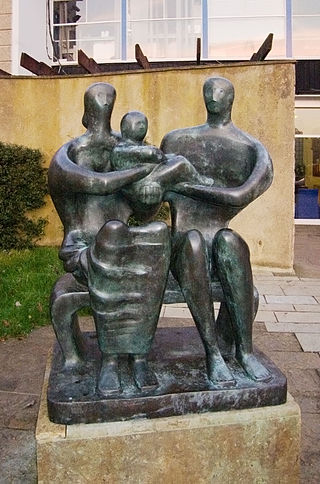
Henry Spencer Moore was an English artist. He is best known for his semi-abstract monumental bronze sculptures which are located around the world as public works of art. As well as sculpture, Moore produced many drawings, including a series depicting Londoners sheltering from the Blitz during the Second World War, along with other graphic works on paper.

Two-Piece Reclining Figure: Points is a sculpture by Henry Moore, catalogued as LH 606, and created in 1969–70.

Reclining Figure 1969–70 is a bronze sculpture by English artist Henry Moore.

Draped Seated Woman 1957–58 is a bronze sculpture by the British artist Henry Moore, cast in an edition of seven in the 1950s. The sculpture depicts a female figure resting in a seated position, with her legs folded back to her right, her left hand supporting her weight, and her right hand on her right leg. The drapery emphasises the female figure, but the facial features are abstracted and barely picked out.

Draped Reclining Woman 1957–58 is a bronze sculpture by British artist Henry Moore, with a series of six castings made by Hermann Noack in Berlin.

Knife Edge Two Piece 1962–65 is an abstract bronze sculpture by Henry Moore. It is one of Moore's earliest sculptures in two pieces, a mode that he started to adopt in 1959. Its form was inspired by the shape of a bone fragment. Moore created the sculpture from an edition of 10 working models in 1962; these working models are now in public collections. Moore created four full-size casts between 1962-1965, with one retained by him. The three casts are on public display on College Green in Westminster, London; Queen Elizabeth Park in Vancouver; and the garden at Kykuit, the house of the Rockefeller family in Tarrytown, New York. Moore's own cast is on display at his former studio and estate, 'Hoglands' in Perry Green, Hertfordshire in southern England. A similar work, Mirror Knife Edge 1977, is displayed at the entrance to I. M. Pei's east wing of the National Gallery of Art in Washington, D.C. The Westminster cast was donated by Moore through the Contemporary Art Society to what he believed was the City of London, but its actual ownership was undetermined for many years. The Westminster cast subsequently fell into disrepair, and was restored in 2013 after it became part of the British Parliamentary Art Collection; it was granted a Grade II* listing in January 2016.

King and Queen is a bronze sculpture by Henry Moore, designed in 1952. It depicts two figures, one male and one female, seated beside each other on a bench, both facing slightly to the left. It is Moore's only sculpture depicting a single pair of adult figures. Moore's records suggest it was originally known as Two Seated Figures.

Reclining Figure: Festival is a bronze sculpture by English artist Henry Moore, commissioned by the Arts Council in 1949 for the Festival of Britain in 1951. The sculpture can be viewed as an abstraction of a reclining female human figure, resting on two arms, with a small head.

Three Standing Figures 1947 is a large stone sculpture by Henry Moore. It was made in 1947–48, and exhibited at London County Council's first Open-Air Sculpture Exhibition at Battersea Park in 1948. Donated to the council, it has been exhibited at the park since 1950. It became a Grade II listed building in 1988.

Three Piece Sculpture: Vertebrae is an abstract bronze sculpture by Henry Moore.

Three-Way Piece No.1: Points is a bronze abstract sculpture by Henry Moore. Three full-size sculptures were cast in 1967, one installed on the Columbia University campus in Upper Manhattan, New York City, and the others at Des Moines Art Center, and Fairmount Park in Philadelphia.

Sheep Piece is a sculpture by Henry Moore made in three sizes from 1969-1972, starting in 1969 with a 14 centimetres (5.5 in) maquette modelled in plaster and then cast in bronze, enlarged in 1971 to a 142 centimetres (56 in) working model in plaster and then cast in bronze, and finally a full size bronze on a monumental scale, 570 centimetres (220 in) high, cast in 1971-72. The four full-size casts are at the Henry Moore Foundation in Perry Green, Hertfordshire, in Zürich, in Kansas City, and at the Donald M. Kendall Sculpture Gardens in Purchase, New York.

Reclining Figure 1938 is a small sculpture by Henry Moore of an sinuous abstracted human figure. An enlarged version was made in 1984 for the Oversea-Chinese Banking Corporation, Singapore. The resulting Large Reclining Figure is some 9 metres (30 ft) long, making it the largest sculpture made by Moore.

Standing Figure: Knife Edge is a bronze sculpture by the English artist Henry Moore. It was cast in two full-size versions: Standing Figure: Knife Edge in 1961, and a larger Large Standing Figure: Knife Edge in 1976. The sculpture also is sometimes known as Standing Figure (Bone) or Winged Figure.

Oval with Points is a series of enigmatic abstract sculptures by British sculptor Henry Moore, made in plaster and bronze from 1968 to 1970, from a 14-centimetre (5.5 in) maquette in 1968 made in plaster and then cast in bronze, through a 110-centimetre (43 in) working model in 1968–1969 also made plaster and then cast in bronze, to a full-size 332-centimetre (131 in) bronze version cast in 1969.

Family Group is a sculpture by Henry Moore. It was his first large-scale bronze sculpture, and his first large bronze with multiple castings. Made for Barclay School in Stevenage, it evolved from drawings in the 1930s, through a series of models to bronze castings in 1950–51. It also one of the last important sculptures that Moore developed from preliminary drawings: in future, he worked mainly from found objects, maquettes and models.

UNESCO Reclining Figure 1957–58 is a sculpture by Henry Moore. It was made in a series of scales, from a small plaster maquette, through a half-size working model made in plaster and cast in bronze, to a full-size version carved in Roman travertine marble in 1957–1958. The final work was installed in 1958 at the World Heritage Centre, the headquarters of UNESCO at the Place de Fontenoy in Paris. This was Moore's last major public commission in which he created a new work for a specific site; he afterwards generally worked from an existing sketch or model.
Reclining Figure is a statue by Henry Moore. The original two-part bronze statue of a human figure was commissioned for the Lincoln Center for the Performing Arts in New York City, where it has been displayed outdoors since 1965 in a pool of water to the north of the new Metropolitan Opera House. Other copies in plaster or bronze exist, and are displayed in other cities.

Three Way Piece No.2: Archer is a large sculpture by the British artist Henry Moore. Two casts exist: cast 1 in Toronto, cast 2 is owned by the National Gallery, Berlin. The work is 340 cm long and 325 cm high. A plaster cast of the work was also made, and was shown in June 1965 at the Queen's Theatre in London as part of a memorial service to T.S. Eliot.

Locking Piece is a sculpture by Henry Moore. It comprises two interlocking forms holding a third element between them, on a bronze base. It is usually mounted on a separate plinth. The sculpture was created in 1962–1964, and bronze casts were made in 1964–1967.























